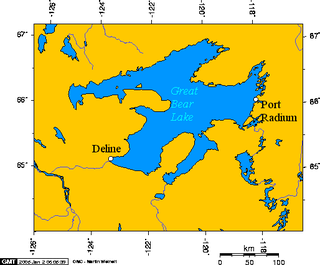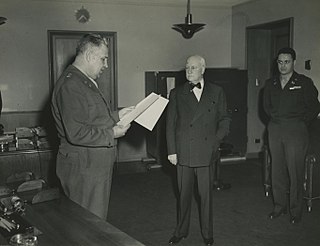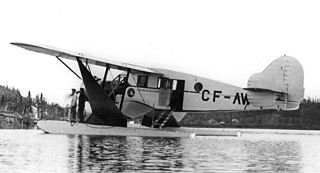
In urban planning, brownfield land is any previously developed land that is not currently in use that may be potentially contaminated. The term is also used to describe land previously used for industrial or commercial purposes with known or suspected pollution including soil contamination due to hazardous waste.

Port Hope is a municipality in Southern Ontario, Canada, approximately 109 km (68 mi) east of Toronto and about 159 km (99 mi) west of Kingston. It is located at the mouth of the Ganaraska River on the north shore of Lake Ontario, in the west end of Northumberland County. Since 1868, the town has been home to Trinity College School.

Uranium City is a northern settlement in Saskatchewan, Canada. Located on the northern shores of Lake Athabasca near the border of the Northwest Territories, it is 230 m (750 ft) above sea level. The settlement is 760 km (470 mi) northwest of Prince Albert, 760 km (470 mi) northeast of Edmonton and 48 km (30 mi) south of the Northwest Territories-Saskatchewan boundary. For census purposes, it is located within the province's Division No. 18 territory.

Port Radium is a mining area on the eastern shore of Great Bear Lake, Northwest Territories, Canada. It included the settlement of Cameron Bay and the Eldorado Mine and Echo Bay Mine. The name Port Radium did not come into use until 1936 and at the time it was in reference to the region as a whole. The Eldorado mine site at LaBine Point adopted the name for its settlement in the 1940s and it has generally stuck.
Gilbert LaBine, OC was a Canadian prospector who, in 1930, discovered radium and uranium deposits at Port Radium, Northwest Territories. He has become known as the father of Canada's uranium industry. LaBine was president of Eldorado Mining and Refining from its start in the late 1920s to 1947. He left the company to prospect for uranium minerals as an independent mine developer. In the 1950s he brought the Gunnar Mine to production at Uranium City, Saskatchewan.

The Rayrock Mine was a uranium producing venture in the Northwest Territories, Canada. It is located on the south side of Maryleer Lake and the north shore of Fault Lake, 169 kilometers northwest of Yellowknife and 74 kilometres northwest of Rae. Radioactive deposits were originally staked in 1948 and then restaked in 1950. American Yellowknife Mines Limited explored the site with detailed Geiger surveys and extensive trenching in the early 1950s. In 1954 exploration work included over 10,000 feet (3,000 m) of surface diamond drilling, and the company was reorganized as Rayrock Mines Limited.

Eldorado Mine is located at Port Radium, Northwest Territories, Canada. Radium, uranium and silver were extracted from the mine during several working periods between 1932 and 1982. Uranium from Eldorado was used in the Manhattan Project. The Eldorado Mine is also known as Port Radium, a name adopted for use at this specific site after 1942. The name Port Radium had previously referred to government facilities at Cameron Bay.

Cameco Corporation is the world's largest publicly traded uranium company, based in Saskatoon, Saskatchewan. In 2015, it was the world's second largest uranium producer, accounting for 18% of world production.
Boris Pregel was a Ukrainian-born Jewish engineer and dealer in uranium and radium. He was born in Odessa, in the Russian Empire, and studied engineering in Belgium at the Free University of Brussels and the University of Liege. He served in the Russian army in World War I, entering as a private soldier and rising to the rank of colonel of engineers. He was put in charge of Russia's only aircraft factory. He moved to Paris after the October Revolution.

Edgar Edouard Bernard Sengier was a Belgian mining engineer and director of the Union Minière du Haut Katanga mining company that operated in Belgian Congo during World War II.

Uranium mining is the process of extraction of uranium ore from the ground. The worldwide production of uranium in 2015 amounted to 60,496 tonnes. Kazakhstan, Canada, and Australia are the top three producers and together account for 70% of world uranium production. Other important uranium producing countries in excess of 1,000 tons per year are Niger, Russia, Namibia, Uzbekistan, China, the United States and Ukraine. Uranium from mining is used almost entirely as fuel for nuclear power plants.

Deloro is a community in geographic Marmora Township in the Municipality of Marmora and Lake, Hastings County in Central Ontario, Canada. Deloro is about 200 kilometres (120 mi) southwest of Ottawa and 65 kilometres (40 mi) east of Peterborough. The Deloro Mine site sits along the banks of the Moira River, along the east side of the community. During the gold rush days, after striking gold in Eldorado in 1866, prospectors built at least 25 shafts on the area now known as the Deloro Mine Site.
Canada has an active anti-nuclear movement, which includes major campaigning organisations like Greenpeace and the Sierra Club. Over 300 public interest groups across Canada have endorsed the mandate of the Campaign for Nuclear Phaseout (CNP). Some environmental organisations such as Energy Probe, the Pembina Institute and the Canadian Coalition for Nuclear Responsibility (CCNR) are reported to have developed considerable expertise on nuclear power and energy issues. There is also a long-standing tradition of indigenous opposition to uranium mining.

Northern Transportation Company Limited (NTCL) was a marine transportation company operating primarily in the Mackenzie River watershed of the Northwest Territories and northern Alberta, and the Arctic Ocean using a fleet of diesel tug boats and shallow-draft barges. NTCL filed for bankruptcy in 2016 and its assets were acquired by the Government of the Northwest Territories later that year.
For many years, North America was the largest exporter of uranium ore in the world and has been a major world producer since demand for uranium developed. In 2009 Kazakhstan took over top spot, relegating Canada to second. 20% of the world's primary uranium production came from mines in Canada in 2009. 14.5% of the world production came from one mine, McArthur River. Currently the only producing area in Canada is northern Saskatchewan, although other areas have had active mines in the past.
The Eldorado Mine, also referred to as the Beaverlodge Operation was a uranium mine in the community of Eldorado, northern Saskatchewan, Canada. Eldorado was a small community 7 kilometres (4.3 mi) east of the community of Uranium City, Saskatchewan in the Beaverlodge Uranium District built by Eldorado Mining and Refining Limited to house the workforce and families of the mine.

Eldorado was a mining town located on Beaverlodge Lake in northern Saskatchewan, Canada. The original name was Beaverlodge. Originally established by the Eldorado Mining and Refining company, the town was later displaced by Uranium City. It housed miners, company families and related workers. A one-room school looked after elementary students up to grade six, after which students were bussed to Uranium City. Eldorado had its own air service of DC-3s and DC-4s, which supplemented commercial air service by Pacific Western Airlines. Air was the accepted mode of travel to and from Eldorado and Uranium City. The nearby Beaverlodge Mine was in operation from 1953 until 1982. Eldorado and Uranium City are along Saskatchewan Highway 962, an isolated stretch of highway.
The country mining the largest amount of uranium is Kazakhstan, which in 2018 produced 41% of the world's mining output. Canada was the next largest producer with a 13% share, followed by Australia with 12%. Uranium has been mined in every continent except Antarctica.

The Radium Queen and her sister ship the Radium King were built in Sorel, Quebec in 1937, for the Northern Transportation Company, a subsidiary of Eldorado Gold Mines. The Radium Queen was a cargo/tug ship that served on the Slave River. It made runs between Lake Athabaska and Great Slave Lake is generally navigable. The Radium Queen towed barges from the railhead at Waterways, Alberta to a portage around the rapids. Cargo was unloaded there and transported by land, and loaded on barges on the lower river that were towed by the Radium King, and later by other tugboats, like the Radium Charles, Radium Express and Radium Yellowknife.

The Eldorado Radium Silver Express was the name of a semi-regular air service between Edmonton, Alberta and Port Radium, Northwest Territories, or between Port Radium and a refinery at Port Hope, Ontario. A single airplane, a Bellanca Aircruiser, a small bush plane, provided this service, from 1935 to 1947.













